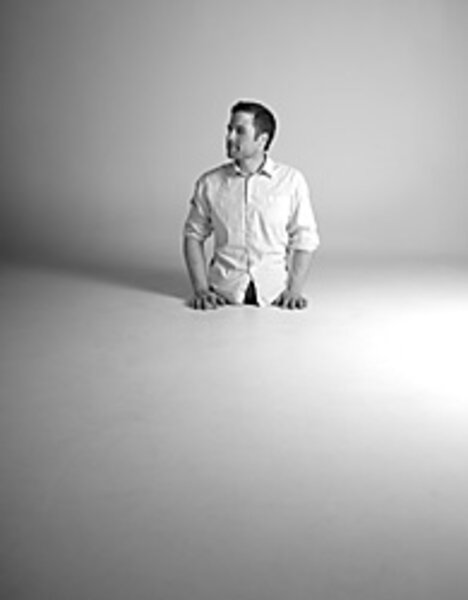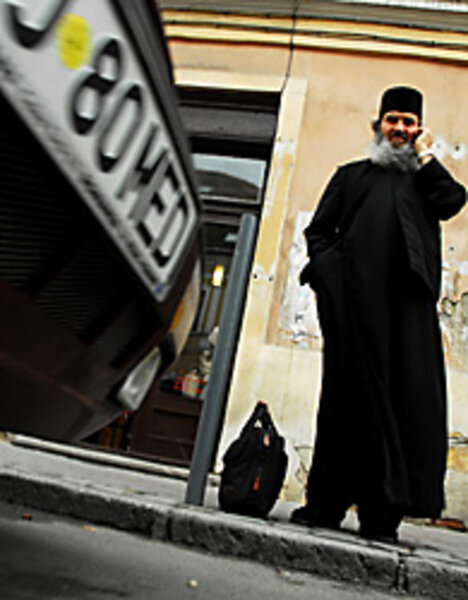A legless artist documents the world in 32,000 stares
| BOZEMAN, Mont.
A 3-foot-1-inch tall man with no legs propelling himself along by his hands on a skateboard tends to warrant a fair share of attention.
People stare.
Sometimes they ask questions. Sometimes they make up stories on their own.
Montana State University film student Kevin Connolly relates a story: In a Bozeman grocery store, a young girl the same height as him asked, "Why are you on a skateboard?" Mr. Connolly replied, "Because I have no legs."
"She just stared at me and had the best question I've ever gotten," he says. "'Is it a trick?'"
Connolly assures that it is no trick. He was born without legs.
While the contrast between his own experience and how people see him can make him angry and frustrated, Connolly is sympathetic to people's curiosity; after all, he's a curious person himself. When someone stares, he wants to know why. Finding the answer has become a personal quest.
As a toddler he didn't immediately grasp that he was any different from his sisters or anyone else. When he was older, his parents enrolled him in gymnastics and wrestling, which strengthened his upper body and gave him the ability to flip up onto counters and do handstands. At age 10, he started skiing, using a monoski specially designed for someone like him.
Estela Allen, a photojournalist who has worked with Connolly since he was in junior high, first spotted him aggressively racing down a ski hill. "He has amazing agility, and amazing strength," she says, crediting Connolly's parents for the sense of self and the confidence he gained by getting involved with his body.
Connolly rarely uses his wheelchair, preferring his skateboard. And a pair of jeans-clad prosthetic legs stand in his apartment as a party novelty, unused since age 12.
"People are wanting effectively to put you in stilts," he says. "Why?"
Connolly feels he's just as able-bodied as anyone. But he never quite adjusted to people's stares.
On a European trip last year he got tired of it. In what he admits to being a passive-aggressive response, Connolly looked the other way, held his camera at hip-level, and snapped a starer's photo.
"I wanted to stare back at that guy, to let him know that, 'Yeah, I catch you looking,'" he says. "And the way I did that was with my camera."
Afterward when Connolly looked at the photo, blurred from both the movement of the camera and the movement of the man, he was surprised to find he liked what he saw. And the seed was planted for a major creative project.
The following summer, bolstered by a grant and by winnings from a second-place finish in the X Games monoski-cross – a side-by-side race for disabled skiers, Connolly packed his bag with camera gear, 14 pairs of duct-tape-reinforced gloves, and his skateboard. He then set off on a journey around the world to explore an aspect of human nature on which he held a unique perspective.
• • •
Connolly traveled to 15 countries in three months, from New Zealand to Japan, through Europe, Iceland, and then through America until he was back in Montana. Always shooting from the hip, he would start his days heading away from the sun, rolling through villages, and shooting people as he rolled. He would break for lunch, edit photos in his digital Nikon, and then start rolling back toward his hostel as the sun started to set.
"Because I'm not looking through the frame, I really wanted to push the idea that this isn't me trying to frame-up a shot and get someone to stare at me; this is just what people are doing. To really focus on the aspect of human nature that the photos present, rather than, 'Oh, look, those are real pretty.'"
Specifically, Connolly is interested in the seemingly instinctual reaction of staring at something that doesn't fit into a person's normal day-to-day existence.
"The thing I just loved was you had an executive-looking type guy in say New York City, someone who's clearly wealthy enough to afford a very nice suit and a good cell phone, staring at you in the exact same way that a beggar in Ukraine would.
"The notion of leveling everyone out through that one universal reaction, I think is really interesting."
Connolly also discovered that people invent stories for him that are closely intertwined with the places they live. In Ukraine, for example, he was thought to be a holy man. In Vienna and much of Eastern Europe, he was taken for a beggar, and people stuffed money into his backpack.
In his hometown of Helena, Mont., he was mistaken for a wounded Iraq war veteran.
But the most troubling narrative for him came in Bosnia, a country still healing from its own war wounds, where Connolly was mistaken for the victim of a Serbian mortar attack.
"The stares I would get felt different than the ones I was getting elsewhere, say in Paris or London," he says. "There was a difficult time when I was trying to figure out if it was an ethical thing to take pictures of people staring at me, when I was basically capitalizing off of exposing their old troubles."
• • •
Connolly returned to Montana with 32,000 photos; he took that many photos, he says, in an attempt to show a cross-section of humanity.
He put many of the photos on his website, TheRollingExhibition.com, and he chronicled his trip in a presentation at Montana State University in October, in which he posed the question, "Is there anything wrong with looking?"
"If every single person does it on the earth reflexively – just on reflex – I wouldn't even say there's so much about it that's right or wrong, it's just something that exists, and needs to be examined a bit more closely. I wouldn't put a right or wrong judgment on staring and curiosity."
The show apparently touched an aspect of curiosity in people – 200 extra seats had to be added to augment ones placed for the expected crowd of 400, and the show was punctuated by cheers and whistles – which surprised Connolly as much as anyone.
"Being born like this and raised the way I was, it's really tough for me to even conceptualize myself as disabled. I just don't have legs. So when someone says I'm really inspirational, it's a little strange, because I just don't think that at all."
But isn't the fact that he doesn't see himself as disabled exactly why he's so inspirational?
"Yeah, and that's always the catch," he shrugs.
Connolly plans to head abroad again next summer, this time to visit South America, Africa, and more of Asia, and take a small documentary film crew along with him.
"I really have to go back out again," he says. "I am curious about the world. I want to go see it."






